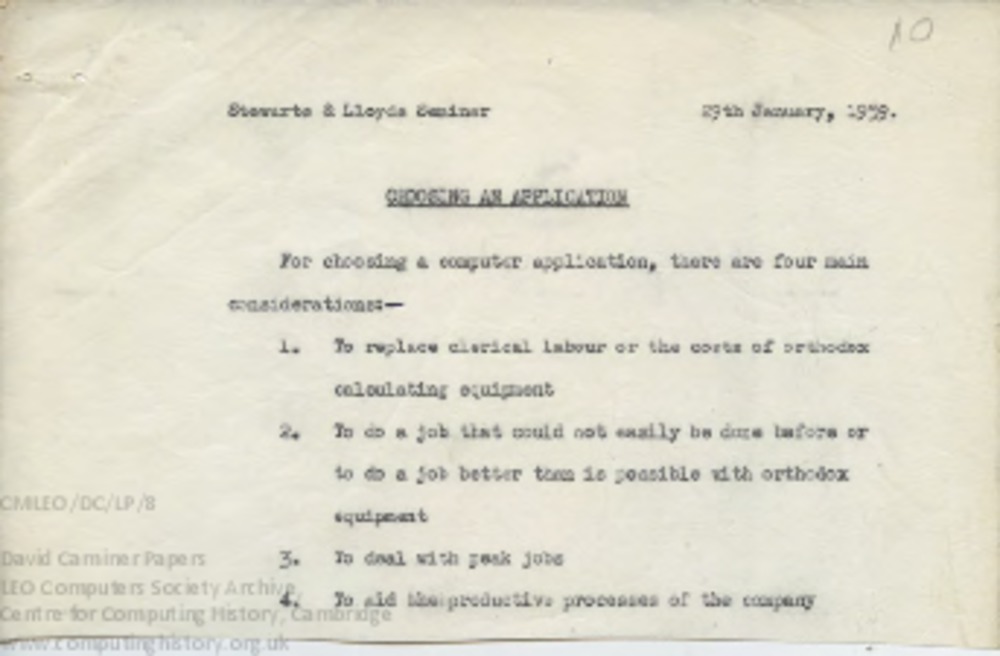
| Home > LEO Computers > Lyons Electronic Office (LEO) Archive > CMLEO/DC - David Caminer Papers > Writings - Lectures, ... pers and Publications > 56690 Choosing an Application |
56690 Choosing an Application
| Home > LEO Computers > Lyons Electronic Office (LEO) Archive > CMLEO/DC - David Caminer Papers > Writings - Lectures, ... pers and Publications > 56690 Choosing an Application |
|
Typescript of David Caminer's paper for the Stewarts and Lloyds Seminar, dated 29th Jan 1959. 'For a computer is a powerful tool. To give its best service it needs to be wielded at a senior level. It is not just a means of doing exactly what was done before in a more modern, labour-saving way'. Related material: Other drafts for similar lectures by David Caminer on Choosing or Selecting an Application were filed separately in his manuscript drafts file - see CMLEO/DC/LP/56557/1. Research comments: Stewarts and Lloyds ordered LEO II/3 in 1958. This document outlines the types of work that the LEO computer could perform for the company. David Caminer starts with extending basic payroll functions (the company had been running its payroll on LEO II/1 since 1957 as part of a service arrangement), by adding calculations of rent payments due to any of three local authorities, maintaining employees' savings accounts and loans, producing better payslips and providing management of the company with statistics on working patterns and overtime. Caminer states that all these processes are repetitive weekly occurances that the computer is ideal for so as to gain maximum value from purchasing their own LEO. He then extends the computer's benefit to Stewarts & Lloyds beyond payroll in suggesting that it could also be used for stores control and accounting (referring to Ford (who ordered LEO II/4 in 1958) as an example of a company already using a LEO for this), and sales invoicing, accounting and warehouse control (referring to HO Wills (who ordered LEO II/2 in 1956) as an example of a company already using a LEO in this way). Caminer also suggests that LEO will help Stewarts & Lloyds to cope with the erratic nature of the substantial pipe stressing calculations it will be doing. The pipes are supplied for power stations and industrial plants, so are not needed everyday. But when they are needed they need to be performed quickly and accurately to many decimal places and LEO is ideal for that. The report suggests that for a human technician to make these calculations for a fairly simple pipe layout it would take a week, whereas LEO can do them in minutes. For more complex arrangements of pipes, the calculations are too extensive to be done by hand, meaning that plans end up being approximate but LEO can do them easily resulting in greater accuracy and safety. LEO's use for mathematical modelling, production control (for example in ore digging and its relationship with furnaces, lorries, steel mixes etc) and distribution planning is also covered. (LM) Date : 29th January 1959Physical Description : 1 item (14 pages), paper; typescript Provenance : Archive References : CMLEO/DC/LP/56690 , DTC/1/10 (part) , DCMLEO20200319044-057 This exhibit has a reference ID of CH56690. Please quote this reference ID in any communication with the Centre for Computing History. |
|










